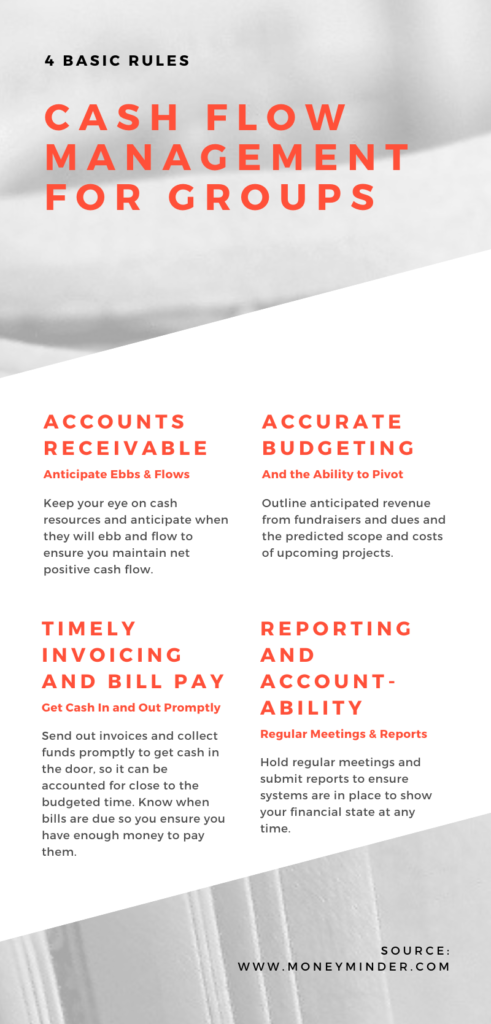Simply put, cash flow management is tracking the money that comes in and out of your nonprofit. It’s one of the essential duties of a nonprofit treasure! If you don’t manage your cash flow, you are putting your nonprofit at risk of more than just cash shortages.
Losing a donor or having to cancel a fundraiser will hurt, but you can strategize to remedy those losses. On the other hand, lacking the cash to pay contractors and vendors is hard to come back from. Cash flow mistakes could be detrimental to your nonprofit.
 Fundraising and Collecting Dues
Fundraising and Collecting Dues
For small nonprofit groups, the goal is to keep your eye on cash resources and anticipate when they will ebb and flow to ensure you maintain net positive cash flow. In the simplest terms, you want more money to come in than goes out.
Many of our groups fundraise early in the school year in order to have enough money to pay for activities during the year. Some groups even go so far as to fundraise the year before they use the money. So, for instance, they might be fundraising this school year with the idea in mind that all of that money will be spent next year. In other words, this year’s activities are being paid for by last year’s efforts. That way they know without question how much they have to work with.
Key Resources:
Sample Fundraising Forms & Letters for Nonprofits
How Should Nonprofit Treasurers Handle Donations?
Fundraising 101
The Role of Budgeting in a Nonprofit’s Cash Flow Management
Budgeting is an important component of cash flow management. Outlining the anticipated revenue from a fundraiser and the predicted scope and cost of an upcoming project are equally important budgeting exercises. Depending on cash flow, some groups need to modify their budgets if a fundraiser falls short of expectations.
Key Resources:
Budgeting Basics Whitepaper
Developing a Nonprofit Budget
Member and Budget Management in MoneyMinder FREE Edition
Timeliness of Invoicing and Billing
Collecting funds promptly will help you get cash in the door, allowing you to account for it close to when you previously budgeted. Knowing when bills-for example, insurance-are due gives you a heads up that you have enough money on hand to pay them. Mapping those out across months ensures that you are prepared when the time comes.
Key Resources:
Treasurer’s Compass eBook
Financial Best Practices for PTO Treasurers
Nonprofit Mobile Credit Card Processing
Reporting & Accountability
Holding regular meetings and having a Treasurer’s Report ensures proper systems are in place and will show the financial position of your organization at any particular point in time. That way you know how you’re doing compared to your budget. Our Budget Analysis Report would be a good one for groups to use to look at different scenarios in the event a fundraiser doesn’t perform as expected.
Key Resources:
Learn About MoneyMinder’s Budget Analysis Report
8 Free Sample Reports for Treasurers
3 Sample Agendas for Effective Volunteer Meetings
 Connect your Venmo account to MoneyMinder PRO to directly download transactions, saving you time and effort. You just review the transactions to ensure they are properly categorized and fill out any required fields.
Connect your Venmo account to MoneyMinder PRO to directly download transactions, saving you time and effort. You just review the transactions to ensure they are properly categorized and fill out any required fields. Connect your Bank, Square and PayPal accounts to MoneyMinder PRO to directly download transactions, saving you time and effort. You just review the transactions to ensure they are properly categorized and fill out any required fields.
Connect your Bank, Square and PayPal accounts to MoneyMinder PRO to directly download transactions, saving you time and effort. You just review the transactions to ensure they are properly categorized and fill out any required fields. Connect your Bank, Paypal and Square accounts to MoneyMinder PRO to directly download transactions, saving you time and effort. You just review the transactions to ensure they are properly categorized and fill out any required fields.
Connect your Bank, Paypal and Square accounts to MoneyMinder PRO to directly download transactions, saving you time and effort. You just review the transactions to ensure they are properly categorized and fill out any required fields. Connect your Bank, Paypal and Square accounts to MoneyMinder PRO to directly download transactions, saving you time and effort. You just review the transactions to ensure they are properly categorized and fill out any required fields.
Connect your Bank, Paypal and Square accounts to MoneyMinder PRO to directly download transactions, saving you time and effort. You just review the transactions to ensure they are properly categorized and fill out any required fields. Join It is a membership management service that helps businesses and nonprofits effectively sell, track, and grow their membership.
Join It is a membership management service that helps businesses and nonprofits effectively sell, track, and grow their membership.